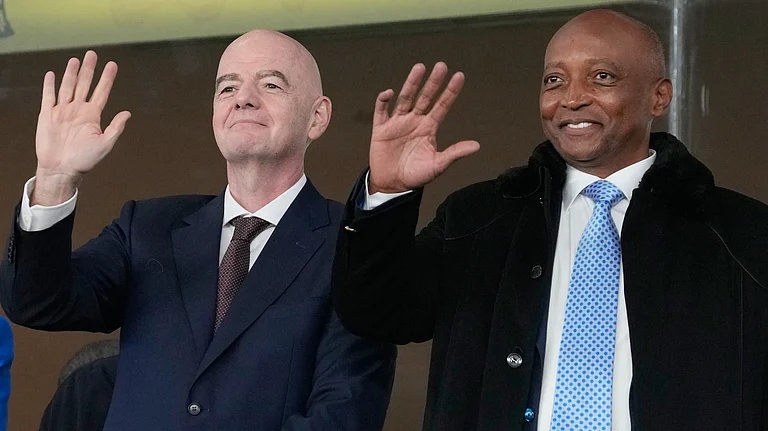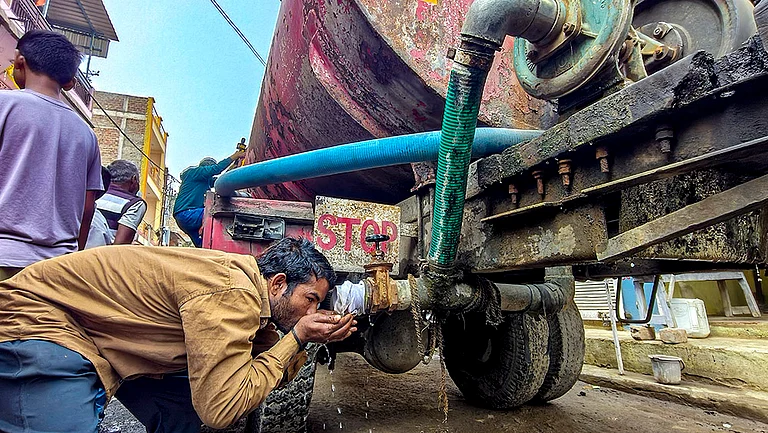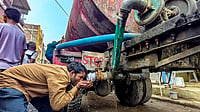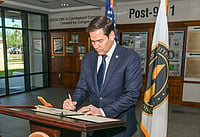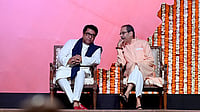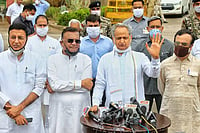THE car suddenly screeches to a halt. Before I realise what's happening, I find myself staring into the barrel of a Kalashnikov, less than a foot away from my head. "Jamaati Cho ?" The two-word question is flung at me. There is a quick flurry in Kashmiri from my companion, a local journalist. The man holding the gun, probably in his early 30s and clad casually in a rust-coloured pherun, takes a hard look at me and then slowly recedes into the alley from where he had emerged.
"I didn't know these people had become active in this area also," remarks my companion as we move on. The gunman belongs to Ikhwan-ul-Muslimoo a militant group led by Jamshed Shirazi, better known as Kukka Parray. The group has declared that its primary task is to 'cleanse' the Valley of all Jamaatis and militants belonging to the Hizbul Mujahideen.
'That Kukka Parray's men have become active in areas near Traal, traditional Hizbul strongholds, is indication enough that the man means business.
The following day we set off in search of him to Hajin in Bandipora where he is frequently based. But before that we run into Ansar-ul Haq, deputy supreme of the Ikhwan-ul-Muslimoon. Ansarul travels in a convoy of Maruti cars, Kalashnikov barrels sticking out of the windows. After some close questioning, he agrees to take us to see Kukka Parray the next day.
As we follow Ansarul's car through the busy market area of Hajin, it becomes obvious that Parray's men enjoy a great rapport with the people. Ansarul and his men throughout exchange greetings with the people as their vehicles meander through the throng of shoppers. Later I am told they have earned this respect due to the relief they provided during the recent floods.
At Halin, we meet Parray, a man who is confident of driving both the Jamaatis and the Hizbul Mujahideen militants away from the Valley. "They have committed great excesses against innocent Kashmiris. We have to eliminate them," he says, puffing on his hookah and surrounded by armed gunmen. He also claims to be fighting for azadi like the JKLF. What about the charge that he has been propped up by Indian security agencies? "Jamaati propaganda," he says dismissively.
His organisation (estimated strength:500 gunmen) has met with considerable success, at least in the Bandipora areas. Once known as a major stronghold of the Hizbul Mujahideen, they are now under the complete sway of Kukka Parray who is said to have further extended his influence to the outlying areas of Srinagar like Rainabari and Gaindarbal.
Indeed, the Valley is now in the grip of a new phenomenon where militants are pitched against militants. Far away in Anantnag in south Kashmir, a group led by Naba Azad is targeting Hizbul militants. It is styled the Muslim Mujahideen as is Sarir Khan's group in the Kandi Sopore belt. Besides, there is Chaudhuri Jalaluddin's organisation, known as the Militant Khilafat Army (earlier the Muslim Liberation Army), working in the Gujjar dominated border area of Kupwara. It is also just a matter of time before the break-away group of the JKLF, led by Shabir Sidiqqi and Basharat Raza and currently holding the Hazratbal shrine, focuses its guns on its former comrades.
Hurriyat leader Syed Shah Geelani and IKLF chief Yasin Malik are certain these groups are receiving help from the security forces. But others like Shabir Shah and Azam Inqlabi, veteran leader of Mahaz-e-Azadi, view the phenomenon differently. Inqlabi attributes the emergence of people like Kukka Parray to Newton's third law of motion: every action has an equal and opposite reaction. Excesses by militants, he says, had to spark off some kind of reaction. And Shabir Shah admits that such excesses were committed by "some militant tanzeems". He says he has personally apologised for all such incidents and issued an appeal to all rebel groups to come back into the fold of the mainstream movement.
Shah admits that three years ago it would have been impossible for the security agencies to locate even 50 Kashmiri gunmen willing to fight other militants Involved in the movement. Now the renegades are exploiting the people's suppressed anger at the excesses committed by the militants.
Gun battles between militant organisations are not new in Kashmir. Such group clashes, particularly between the pro-Pakistan Hizbul Mujahideen and the pro -independence JKLF were routine occurrences during 1990-91. But they had eased considerably in the last couple of years only to start recurring in a big way. This year alone, a total of 116 group clashes resulting in the death of 127 militants, had been reported till the end of August.
For government officials, there could be nothing better than this turn in events. While they hotly deny charges of connivance with the renegades, they can't stop smiling. "Oh, they are definitely making our jobs easy. We have no reason to complain," says a senior official in Srinagar.
What he probably doesn't realise is that these gunmen could become as uncontrollable as the others in the longer run and the whole situation may well develop into a civil war of sorts. That, however, doesn't worry the officials. that Their attitude is: "We will cross bridge when we come to it. For the moment, our battle is against the secessionists."







